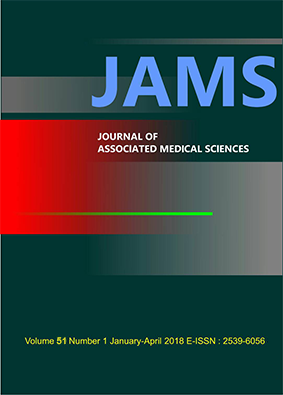Volumetric and dosimetric comparison of helical tomotherapy treatment planning using different strategies of four dimensional computed tomography images for target volume definition in non-small cell lung cancer patients
Main Article Content
Abstract
Background: Four-dimensional computed tomography (4DCT) images were used to generate internal target volume (ITV) in lung cancer. However, the drawback is time consumed to delineate all sets of CT scans. Maximum intensity projection (MIP) and select phases of 4DCT datasets were used to reduce time consumed to delineate the ITV.
Objectives: To compare the volume of ITV and dosimetric parameters of planning target volume (PTV) based on three different 4DCT datasets in non-small cell lung cancer (NSCLC) patients of helical tomotherapy treatment planning.
Materials and methods: The 4DCT image datasets of 7 patients diagnosed with stage I-III NSCLC were used. All gross target volumes (GTVs) were delineated by the same radiation oncologist in 3 different 4DCT datasets (10 phases, 3 phases, and MIP image) using Oncentra Master Plan v.4.3 contouring software. PTV10phases, PTV3phases and PTVMIP were generated and treatment planning were performed. From PTVs contour, volume and ratio of ITV as well as matching index (MI) were compared. Helical tomotherapy planning was done for each PTV then dosimetric parameters for PTVs and organs at risk (OARs) were evaluated. Statistical analysis was performed using Pair t- test and a p<0.05 was considered to be statistically significant.
Results: Mean volume of ITVs were 64.09±63.05 cc, 60.40±60.99 cc, 59.85±60.23 cc for ITV10phases, ITV3phases and ITVMIP, respectively. The ITV3phases and ITVMIP were significantly smaller than the ITV10phases (p<0.05). The mean ratios between ITV3phases and ITV10phases and between ITVMIP and ITV10phases were 0.93 and 0.92, respectively. The mean MI between ITV3phases and ITV10phases and between ITVMIP and ITV10phases were 0.90 and 0.87, respectively. For the mean MI and the mean ratios of ITVs, there was no significant difference between ITV3phases versus ITV10phases and ITVMIP versus ITV10phases. For dosimetric parameters of PTVs, the average V95 of PTV10phases, PTV3phases and PTVMIP were 99.51%, 99.65% and 99.68%, respectively. The average V107 of PTV10phase, PTV3phases and PTVMIP were 0.24%, 0.22% and 0.23%, respectively. About OARs dose, only statistically significant difference was found in the Ipsilateral lung dose (V20 and V30) of PTV10phases and PTVMIP.
Conclusion: MIP images are reliable for creating ITVs in early stage patients. The 3 phases images data sets are reliable for generating ITVs for all stages of NSCLC in which tumor moves straightforward superoinferior (SI) direction and that tumor deformation during breathing are minimal. Dosimetric parameters of all 3 PTVs generated by using 3 different ITV definitions are similar.
Article Details
Personal views expressed by the contributors in their articles are not necessarily those of the Journal of Associated Medical Sciences, Faculty of Associated Medical Sciences, Chiang Mai University.
References
[2] Underberg RWM, Lagerwaard FJ, Slotman BJ, Cuijpers JP, Senan S. Use of maximum intensity projections (MIP) for target volume generation in 4DCT scans for lung cancer. Int Radiat Oncol Biol Phys2005;63:253-60.
[3] Khan F, Bell G, Antony J, Palmer M, Balter P, Bucci K, et al. The use of 4dct to reduce lung dose: a dosimetric analysis. Med Dosim 2009; 34: 273-8.
[4] Bai T, Zhu J, Yin Y, Lu J, Shu H, Wang L, et al. How does four-dimensional computed tomography spare normal tissue in non-small cell lung cancer radiotherapy by defining internal target volume. Thoracic Cancer2014; 5: 537-42.
[5] Wang L, Hayes S, Paskalev K, Jin L, Buyyounouski MK, Ma CM, et al. Dosimetric comparison of stereotactic body radiotherapy using 4D CT and multiphase CT images for treatment planning of lung cancer: evaluation of the impact on daily dose coverage. Radiother Oncol 2009; 91: 314-24.
[6] Muirhead R, Stuart G, Featherstone C, Moore K, Muscat S. Use of maximum intensity projections (MIPs) for target outlining in 4DCT radiotherapy planning. Journal of Thorac Oncol 2008; 3: 1433–8.
[7] Rietzel E, Liu AK, Doppke KP, Wolfgang JA, Chen AB, Chen GT, et al. Design of 4D treatment planning target volumes. Int Radiat Oncol Biol Phys2006; 66: 287-95.
[8] Ezhil M, Vedam S, Balter P, Choi B, Mirkovic D, Starkschall G, et al. Determination of patient-specific internal gross tumor volumes for lung cancer using four-dimensional computed tomography. Radiat Oncol 2009; 4: 1-4.
[9] Menzel HG, Wambersie A, Jones DTL, et al. The ICRU report 83, Prescribing, Recording, and Reporting Photon-Beam Intensity-Modulated Radiation Therapy (IMRT). Journal of the ICRU 2010 april;10.
[10] Bradley J, Schild S, Bogart J, Dobelbower M, Choy H, Adjei A, et al. A randomized phase III comparison of standard- dose (60 Gy) versus high- dose (74 Gy) conformal radiotherapy with concurrent and consolidation carboplatin/paclitaxel +/- cetuximab (ind #103444) in patients with stage IIIA/IIIB non-small cell lung cancer [Internet]. 2016 [cited 2017 Jul 20]. Available from: https://www.rtog.org/ClinicalTrials/ProtocolTable/StudyDetails.aspx?study=0617
[11] Zhou YQ, Xie CY, Yi JL,Han C, Zheng XM, Jin XC. Volumetric and Dosimetric Influences of Internal Target Delineation Based on 4D CT Measured Tumor Motion in the Treatment of Lung Cancer with Stereotactic Body Radiotherapy. Austin J Radiat Oncol & Cancer 2015; 1(1): 1005


